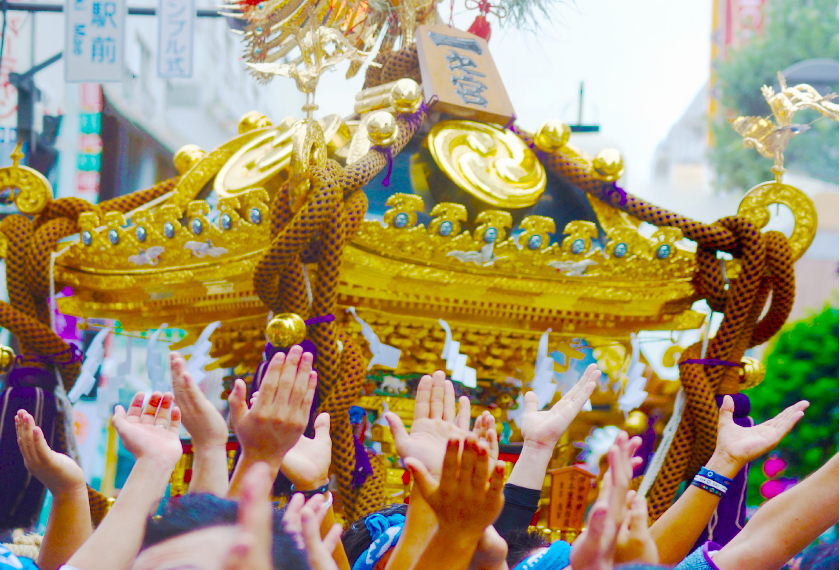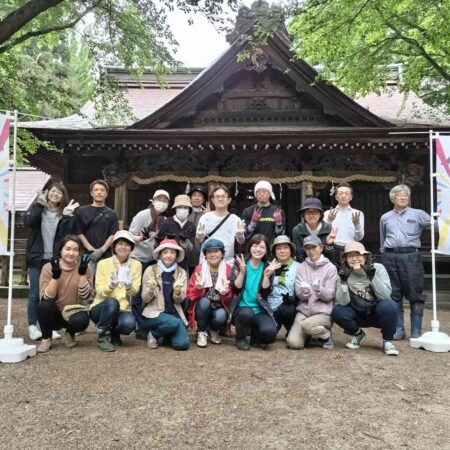おみこしって何?お祭りにはどうすれば参加できる? What is Omikoshi? How can you join the festivals?

おみこしの写真をネットで見たり、学校や会社でお祭りの話を聞いたりして、お祭りに参加したい、おみこしを見たいと思う人も多いのではないでしょうか?
自分もおみこしをかついでみたいと思う人もいるかもしれませんね。
そこで今回は、おみこしについて日本語と英語で紹介します。
Contents
おみこしは神様の乗り物 Omikoshi is a carriage for the gods

おみこしは「持ち運べる神社」と説明されるように、神社の神殿を模したつくりになっています。
屋根には鳳凰という想像上の鳥の飾りがついていて、神社でよく見かける鳥居や囲垣も飾られています。狛犬というライオンのような霊獣の像が置かれているおみこしもあります。
おみこしの本来の意味は、神様が神社からお出かけする時に乗る乗り物のことです。
「こし」は人を乗せて持ち上げて運ぶ乗り物のことで、「み」は敬意を表す言葉です。
「みこし」にさらに丁寧に「お」をつけて「おみこし」と呼ばれます。
昔は神官だけがおみこしを使っていましたが、中世の鎌倉時代ごろから民衆の祭りにもおみこしが使われるようになりました。
農村の豊作祈願などの願いを聞き入れたりするために行われたと言われています。
An Omikoshi is modeled after a shrine. It is known as a “portable shrine.”
The roof is decorated with a phoenix, an imaginary bird, and torii gates and fences that are often found near shrines. Some Omikoshis have lion-like statues of spiritual beasts called Komainu.
Originally, Omikoshi are carriers where gods would ride when leaving the shrine.
“Koshi” means a carrier that lifts and carries people, and “mi” is a word to show respect.
You can say “Omikoshi” by adding an “O” to show more politeness.
In the past, only Shinto priests would use Omikoshi. Around the Kamakura period during the Middle Ages, Omikoshi would be used during common festivals.
It is said carrying out an Omikoshi would grant good fortune, such as providing a good harvest for villages.
おみこしの祭りは1年中 The Omikoshi festival is held all year round

おみこしの行事は、日本では一年を通して各地で行われています。
季節によって違った目的があります。春は豊作や地域の発展、夏は疫病退散や鎮魂のため、秋は収穫や豊漁への感謝、冬は厄除けといった目的です。
おみこしは全国あらゆる地域で見ることができます。中には多くの観光客が来るお祭りもあります。
東京で有名なおみこしの行事は浅草の三社祭です。毎年5月に開催され、多いときには100万人以上の見物客が来ます。
おみこしをかつぐ様子が、荒れ狂うように迫力があるものは「荒神輿」と呼ばれ、特に人気があります。
宮城県で3月に行われる「帆手祭」、兵庫県で10月に行われる「灘のけんか祭」、愛媛県で10月に行われる「北条秋祭り」の3つが「日本三大荒神輿」として有名です。
旅行のプランに組み入れてはいかがでしょうか?
Omikoshi events are held across Japan all year round.
They have different purposes depending on the season; providing a good harvest and good fortune for land development during spring; warding off epidemics and laying departed souls to rest during summer; returning gratitude for the harvest and good fortune during autumn; and warding off evil during winter.
Omikoshi can be found all over Japan. Some festivals attract a lot of tourists.
A big Omikoshi Festival in Tokyo is the Sanja Matsuri in Asakusa. The festival is held every May, and it has attracted more than 1 million peak visitors.
The raging and powerful performance “Ara-Mikoshi” is particularly popular.
Miyagi Prefecture’s “Hote Matsuri” in March, Hyogo Prefecture’s “Nada no Kenka Matsuri” in October, and Ehime Prefecture’s “Hojo Aki Matsuri” in October are known as “The Best 3 Ara-Mikoshi.”
How about including them in your travel plans?
おみこしのかつぎ方とマナー How to hold a Omikoshi and etiquette
実はとても重いおみこし The Omikoshi is actually very heavy
おみこしは小さいものでも数百キロあり、三社祭のような大きなお祭りの場合、1トン以上の重さがあります。
そんなおみこしをうまく扱えるよう、かつぎ手は稽古をします。慣れないうちは、肩やふくらはぎが痛くなるかもしれません。
Even a small Omikoshi weighs hundreds of kilograms; and for big festivals like the Sanja Matsuri, it weighs more than a ton.
Carriers are trained to handle Omikoshi. Before you get used to it, your shoulders and calves would likely hurt.
おみこしのかけ声 Omikoshi shouts
おみこしのかつぎ手は、「わっしょい」と全員で声を合わせて叫びます。
このかけ声の語源は「和し背負え(わししょえ)」であるという説があります。「わし」は「和(調和)し」、「しょえ」は背中に乗せることです。
重いおみこしをみんなで一つになってかつごうという気持ちをこめて叫んでください。
All Omikoshi carriers shout “Wasshoi” in unison.
This shout has origin. There is a legend where “Wa-shi” means to harmonize, and “shoe” means to carry a heavy load on your back.
Please shout becoming one with everyone, putting your all to carry the Omikoshi together.
神様を敬う Worship gods
おみこしを肩に担ぐのは、神様を敬い、人の身長より高く掲げるためです。
休憩するときにもおみこしは地面に下ろさず台の上に置くことになっています。
なお、かついだ時に激しく揺さぶるのは、神様の霊力を振りまくためだと言われています。
神道の大きな特徴は、神様は数多くいるという教えがあることです。どんな宗教を持っている人でも受け入れられます。
かつぐときはもちろん、見物するときも神様に敬意を払うことを忘れないようにしましょう。
Carrying the Omikoshi on your shoulder is to worship the gods, raising them higher than yourself.
Even when taking a break, the Omikoshi is placed on a pedestal, never on the ground.
It is said the reason for the violent shaking is to spread the gods’ spiritual power.
Shintoism is particularly known to depict many different gods in its religion, so people from other religions are welcome.
Whether you are a carrier or a spectator, don’t forget to pay your respects to the gods.
まとめ:あなたもかつぎ手になれるYou can be a Mikoshi carrier

おみこしは、数十年前までは「氏子」という、それぞれの神社を崇め奉っている人たちが担ぐものでした。
しかし今は、氏子だけでかつぐのが人手不足により難しくなっているため、地域に神輿保存会ができて一般の参加者をたくさん募集しています。
町内か近隣に住んでいるか、勤務していれば参加できます。
おみこしの衣装である半纏(はんてん)を貸してもらえるので、見るだけより、お祭りに参加した実感がわくはずです。
おみこしに興味がある方や地域との交流の場を持ちたい方は、地元のお祭りに参加してみてはいかがでしょうか。
Until several decades ago, Omikoshi was carried by “Ujiko,” the worshipers of each shrine.
However, due to the lack of manpower, it would be difficult for the Ujiko to carry the Omikoshi by themselves. That is why the Mikoshi preservation society was established for each area, inviting the general public as participants.
If you live or work nearby, you can participate.
You can borrow a Hanten, worm by Omikoshi carriers, giving you a glimpse of being a real Omikoshi carrier when participating.
If you are interested in Omikoshi, or if you want to connect with the local community, how about consider participating?










